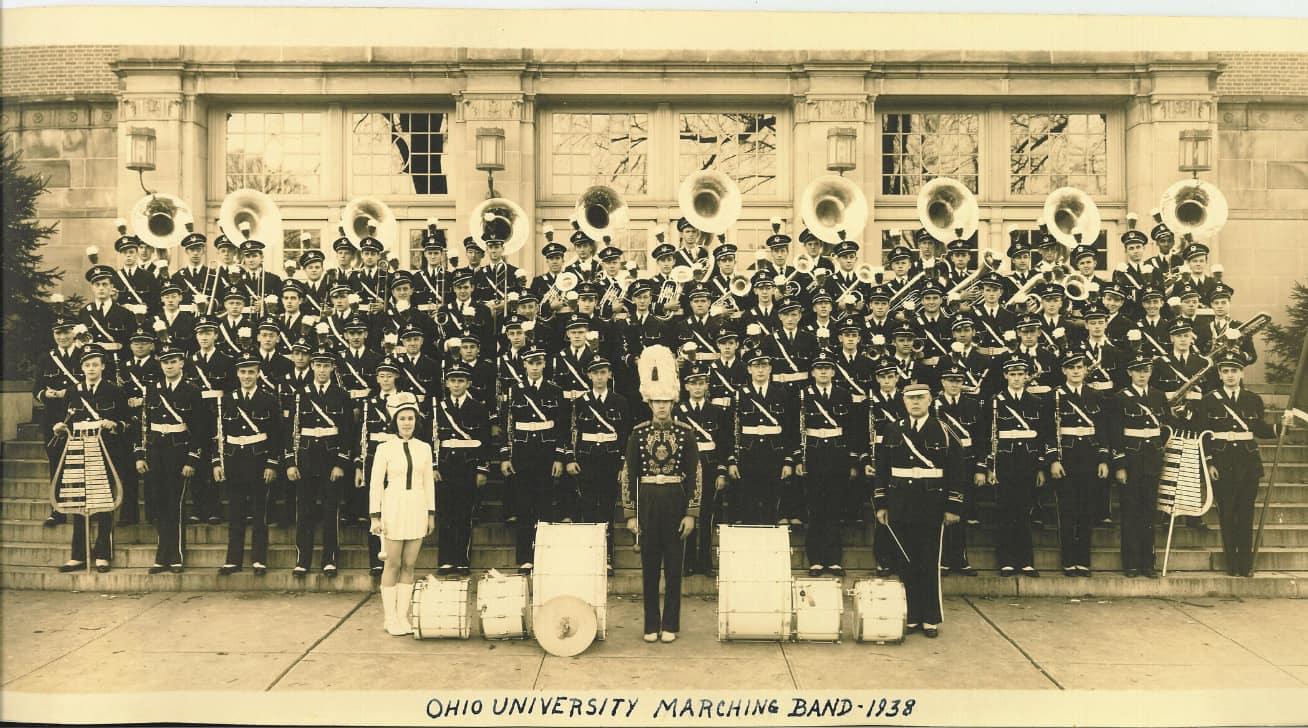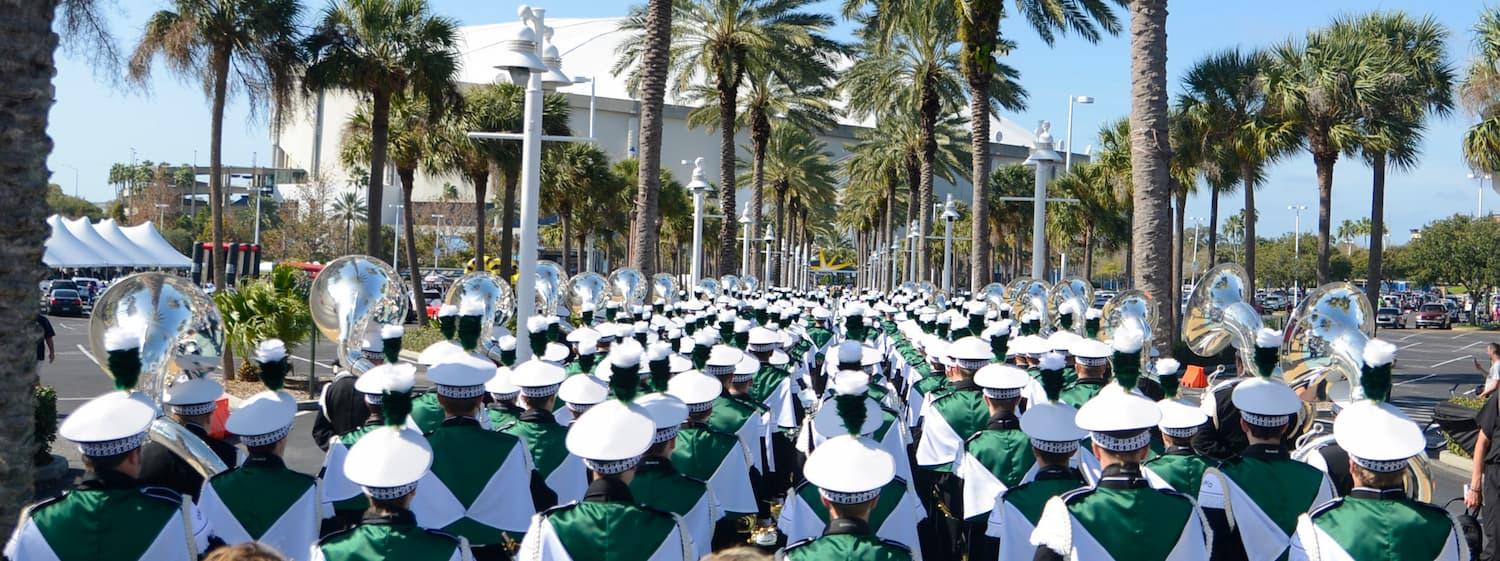
History

A Brief History
1923–1966: From the Beginning: The Formation of the Ohio University Marching Band
In 1923, an Ohio University student by the name of Homer Baird decided that Ohio University needed a marching band of its own. So he organized the first meeting about such a group at Ewing Hall where over 40 musicians were in attendance.
At that meeting, Baird was elected president and he made arrangements with a local instrumental teacher named Raymond Connett to direct the band for free. Baird is quoted as saying, "Fortunately, we had at least 25 top-notch musicians and the others were coming along fine." Enough money was raised to furnish the band with about 30 blue coats and white caps, while the members had to buy their own white trousers.
During the football season, the town of Athens raised enough money to send the band with the football team on a special train to play OHIO's toughest rival (Ohio Wesleyan) on their Homecoming Day. After the game, the Ohio Wesleyan fans stated "that [OHIO] was the best band that had been on their gridiron that year."
After the 1924 season, the records are unclear as to who directed the band and when. Around 1927, Curtis Janssen took over the direction of the OUMB and arranged the Ohio University's Alma Mater. Janssen also established an all-girls band, which was disbanded after he left OHIO. When Janssen left, Professor Dan Martino took over the OUMB and after Martino came Professor Charles Gilbert. Gilbert and his assistant, William Brophy, reestablished the all-girls band along with majorettes.
In 1950, the OUMB was a female-only band while many of the men were off at war. Charles Minelli took over the direction of the Ohio University Marching Band in 1952 and held the baton until 1966, when Gene Thrailkill came from the University of Michigan, and began what was to be the biggest change ever in the Ohio University Marching Band.
1967: "The Big Switch"
Prior to 1967, the men in the band wore green blazers and gray slacks with striped green and white ties, while the women wore the same blazers and ties, but with gray skirts. But in 1966 when Gene Thrailkill took over the direction of the OUMB, the "big switch" came about. This included removing all women and majorettes from the band in the 1967 fall marching season. Despite the removal of the majorettes, Thrailkill decided to keep a drum major and a twirler.
In 1967, Thrailkill introduced the hard-driving, high-energy style you see today. Bill Fay was the first drum major of the "Marching Men of Ohio," while freshman David Fowler was the twirler (Fowler would later begin the tradition of dancing to "Ain't Been Good" which the 110 still performs today). The removal of women from the band caused quite a big controversy in Athens resulting in articles in The Post (Ohio University's student newspaper) and letters to the editor. According to Tom Edwards (OUMB announcer 1966-1969), Thrailkill gave a big pep-talk before the first home game in 1967. "He said that the drive-on and the first note of Stand Up and Cheer would either make or break this band forever. Obviously, the student body was absolutely blown away -- and the controversy died a very quick death." In 1975, under the direction of Ronald P. Socciarelli, women were readmitted into the marching band, while retaining the name "Marching 110."
During the first year of the "new" band, the band was called the "100 Marching Men of Ohio," similar to the "Marching Men of Michigan;" Thrailkill's Alma Mater. The next year, in 1968, the band became known as the "110 Marching Men of Ohio;" the 110 symbolizing the Marching 110 of today.
Many other changes involving the band occurred in the late 60's as well. The Ohio University fight song, Stand Up and Cheer, debuted in it's current form with a fanfare to introduce the song. The Ohio University Alma Mater was also changed with the addition of a new introduction.
Past Directors
- Raymond Connett, 1923-1925
- John Hollingsworth Gill, 1926-1928
- Curtis William Janssen, 1929-1945
- Daniel Martino, 1946-1947
- Charles Everett Gillbert, 1948-1950
- Charles Minelli, 1951-1966
- Gene Thrailkill, 1967-1970
- Thomas Lee, 1971-1972
- Ronald P. Socciarelli, 1973-1989
- Sylvester Young, 1990-1995

Highlights of the Ohio University Marching Band
- In 1974, the 110 began the annual tradition of performing at the Ohio Theatre in Columbus, Ohio.
- On October 28, 1976 the Marching 110 became the first marching band ever to perform in Carnegie Hall in New York.
- In 1993, the Marching 110 traveled to Washington DC to play in the Inaugural Parade for Bill Clinton. The 110 then also played a concert for the presidential inaugural ball.In October 1996 the Marching 110 opened for First Lady Hillary Clinton's speech at Baker Center in Athens.
- In September 1998, the Marching 110 performed the opening ceremonies for the LPGA Solheim Cup on the 18th fairway at the Muirfield Village Golf Club in Dublin, Ohio.
- In October 1998, the Marching 110 had the honor of performing at the Playhouse Square Light the Lights opening of the restored Allen Theatre. The show featured The Alice Farley Dancers, several of Cleveland's corporate leaders, Ohio Governor George Voinovich and his wife Janet, Broadway director, choreographer and dancer Tommy Tune, the Manhattan Kings, the Cleveland Opera, the Cleveland San Jose Ballet, Ohio Ballet, Dance Cleveland, the Great Lakes Theater Festival and Dancing Wheels, Mike Burstyn the star of "Jolson," and finally the Ohio University Marching 110.
- During the 1999 marching season the Marching 110 performed at the Ohio/Ohio State game in Columbus, the Cincinnati Bengals/St. Louis Rams game in Cincinnati, and the Cleveland Browns /Baltimore Ravens game in Cleveland. It marked the first time that the 110 had ever performed in the three largest stadiums in the state of Ohio all in the same season. The Ohio State game drew a crowd of 93,222, the Bengals had 45,481 in attendance, and the Browns drew 72,898.
- Also during the 2000 season, the Marching 110 performed for an estimated 2.5 million live viewers and an estimated 65 million NBC viewers in the Macy*s Thanksgiving Day Parade. Also while in NYC on Thanksgiving Day, the 110 appeared on Good Morning America during a live update from the parade and was also shown later that day on The Late Show with David Letterman.
- On September 30, 2001, the Marching 110 took part in one of the most emotional events of the year. Less than three weeks after the September 11th tragedy in New York City, the 110 took the field for halftime of the New York Giants football game, the first since the terrible events of 9/11. In front of over 70,000 fans, the 110 took part in one of the most memorable games in recent history. After the 110 pregame show, the Harlem Boys Choir sang our National Anthem, and Tony Bennett led in the singing of "America the Beautiful." The moment was highlighted by the visit of representatives of the NYC Fire and Police Departments. The Marching 110 also made a donation to the N.Y.F.D. in memory of those lost in the events of 9/11.
- At the end of the 2002 season, the Marching 110 traveled south to Florida to perform for the Ohio/University Central Florida Game. While in Florida, the 110 also performed at Walt Disney World, and the Jacksonville Jaguars vs. Pittsburgh Steelers game in Jacksonville, Florida.
- In 2005, the Marching 110 once again performed in New York City at the 29th Annual Macy*s Thanksgiving Day Parade, this time having the honor of being the lead band.
- In 2006, 15 members of the Marching 110 traveled to Hollywood, California, to perform as surprise guests on NBC's hit game show, "Deal or No Deal."
- On New Years Day 2010, the Marching 110 participated in the 121st Tournament of Roses Parade in Pasedena, California.
- In May 2013, the Marching 110 performed in Dublin, Ireland and St. Peter's Square, Vatican City, Rome.
